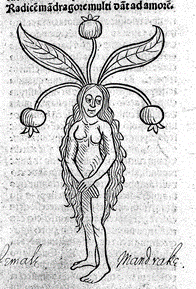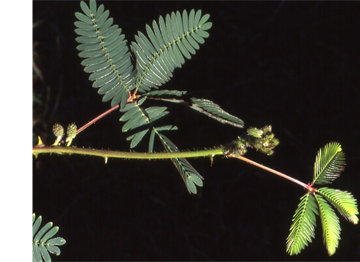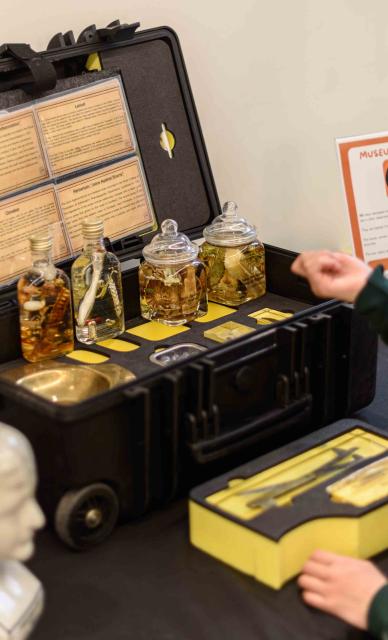Support us
As a charity we rely on your donations to fund our free exhibitions, school activities and online resources
Empowering medical excellence, shaping healthcare futures.
Being surrounded by nature, wandering through a garden or a forest, can be a full sensory experience. You smell flowers and trees in bloom, sometimes (if not often) sweetened by that scent of recent rainfall, you can hear birds sing or leaves rustle, you can feel petals between your fingers. Humans have always experienced botany through more than just the sense of sight, often considered the more dominant one. Here, we will look at some examples of how plants and botanical knowledge were thought about through the five senses.

One of the senses that is often considered the most dominant is sight. What can we tell about what a plant is just by looking at it? Naturally, this can be quite a lot. Following the traditional Linnaean classification system, which ‘revolutionised’ (botanical) taxonomy, it becomes clear just by seeing what sort of leaves, roots or stem it has in where on the hierarchy the plant belongs.
Historically, when it came to going a step further and deduce the medicinal use of a specific plant, simply looking at it was occasionally considered an accurate indicator. It is, it should be said, often argued (in a what-came-first-chicken-or-egg way) that it’s impossible to test whether people used to identify a plant’s medicinal use just by looking at it or whether ‘signatures’ were later applied to better remember its use.

One of the most famous examples for this association is probably the mandrake. Its human-like shape definitely contributed to its connections with fertility, amongst many other health issues, and some people slept with them under their pillows as ‘lucky charms’. On the other hand, its human features also fed into associations with supernatural or even demonic beings. This led to certain myths and legends maintaining that if you uprooted a mandrake, its screams could be deadly.
Slightly less extreme examples for the doctrine of signatures were, for example, saxifrage (more commonly known as rockfoil): as it grows the plant can break through rocks, so medicinally, it was used to treat kidney stones. Similarly, walnuts were frequently used for headaches or injuries since they resemble the human brain.
However, it was not necessarily just the directly visible characteristics of a plant that made up a signature. More ‘invisible’ things like taste and smell could also contribute to a plant’s association as a specific remedy. Smell had a double meaning for disease - pleasant fragrances were prescribed for their therapeutic and healing qualities, whereas foul stenches were feared for their alleged role in spreading disease. A famous example for this idea was the Greek theory of miasma (“pollution”). Featuring heavily in narratives of the plague of Athens or of Thebes, it described the idea that poisonous vapours spread through the air, originating for example from dead bodies, and infected people in this way. This idea continued to exist for many centuries up until the late 1800s. Florence Nightingale, for example, also emphasised the need for “fresh-smelling” hospitals. The miasma theory has been largely replaced by the germ theory, which can explain a disease spreading through both direct and indirect physical contact.
The medicinal qualities of fragrant plants remained important throughout this period. In 1489, the Italian physician Marsilio Ficino maintained that the odours of herbs, flowers and trees, no matter how little of it you may actively notice, can still “restore and invigorate you [...] as if by the breath and spirit of the life of the world”. In our exhibit De Stirpium, one of the so-called ‘German fathers of botany’ Hieronymus Bosch even lists herbs and odoriferous (‘smell-carrying’) plants as one of the categories in his new classification scheme.
Some plants sought out specifically for the qualities of their fragrance are thyme, whose ‘bracing fragrance’ was said to evoke courage in people. Another example is yarrow or sneezewort, which - as the name suggests - had such a pungent smell that it made people sneeze and clean out their sinuses that way. Generally, gardens were frequently seen as a place of refuge and comfort for ill people and smell could play a large part in this.
Sir John Floyer, an English physician from the mid-1600s, studied his medicinal plants by chewing them. He went so far as to develop a complicated catalogue of plant tastes, which included the ‘bitter sweet’ or ‘bitter acid’. According to him, taste was a physician’s most dependable tool because it could reveal how a plant, for example, could affect the body.
In the traditional hierarchy of the senses, it was often said that sight and hearing were associated with the soul, whereas touch and taste were often considered bodily senses (smell was considered in the middle). How can we look at botany through the sense of touch? One plant in particular does not want us to do precisely that. Commonly known as a ‘Touch-Me-Not’ plant, the mimosa pudica (pudica meaning shy, shrinking, bashful) folds its leaves into itself when it is touched. Nowadays, it grows in most tropical regions of the world but it has a long history of having baffled botanists, philosophers, and scientists alike.

We know now that the plant’s ‘recoiling’ is caused by a kind of motor function in specific cells located near the stems, but the mystery of it confused researchers of many disciplines. Some people used to believe that the mimosa pudica had a close connection with love and sex and could ‘heal’ unrequited love or even restore a woman’s virginity. Generally, the sense of touch was, in the realm of botany and philosophy, considered to be equivalent to smell in that blind people could potentially feel authentic plants and distinguish them from copies.
Author: Isabel Lauterjung
Further reading and references:
- Kettler, Andrew. 2017. “‘Delightful a Fragrance’: Native American Olfactory Aesthetics within the Eighteenth-Century Anglo-American Botanical Community”, in Empire of the Senses, pp.223-254
- Jenner, Mark S.R. 2010. ‘Tasting Lichfield, Touching China: Sir John Floyer’s Senses’, in The Historical Journal, Vol. 53 (3), pp.647-670
- Rawcliffe, Carole. 2008. “Delectable Sightes and Fragrant Smelles: Gardens and Health in Late Medieval and Early Modern England”, in Garden History, Vol. 36, pp.3-21
- Hickman, Clare. 2021. The Doctor’s Garden: Medicine, Science, and Horticulture in Britain (New Haven: Yale University Press)
- British Art Talks Podcast. 2020. “The Medicinal Garden” (Season 1, Episode 7) with Anna Reid, Clare Hickman, Claire Preston, and Carole Rawcliffe. [accessible here: https://audioboom.com/posts/7615397-the-medicinal-garden]
- Carter, Anthony John. 2003. “Myths and Mandrakes”, in Journal of the Royal Society of Medicine, Vol. 96 (3), pp.144-147
- Palmer, Richard. 1993. “In bad odour: smell and its significance in medicine from antiquity to the seventeenth century”, in Medicine and the Five Senses, ed. by W.F. Bynum and Roy Porter, (Cambridge: Cambridge University Press)
- Goodden, Angelica. 2014. “Bouquets and the Blind”, in Diderot Studies, Vol. 34, pp.269-282
- Bennett, Bradley C. 2007. “Doctrine of Signatures: An Explanation of Medicinal Plant Discovery or Dissemination of Knowledge?”, in Economic Botany”, Vol. 61 (3), pp.246-255
- Giglioni, Guido. 2018. “Touch Me Not: Sense and Sensibility in Early Modern Botany”, in Early Science and Medicine, Vol. 23, pp.420-443
- National Records of Scotland - Hairy Thyme [https://www.nrscotland.gov.uk/research/archivists-garden/index-by-plant…]
- https://www.britannica.com/science/taxonomy/Ranks
- https://en.wikipedia.org/wiki/Miasma_theory
- http://gardenersapprentice.com/gardeningtips/sneezewort/
Image sources:
Mandrake: Hortus Sanitatis, Wikimedia Commons licence [https://commons.wikimedia.org/wiki/File:Hortus_Sanitatis;_mandrake_Well…]
Saxifrage: Egenolff's Herbarum, aborum [https://www.rcpe.ac.uk/heritage/christian-egenolff]
Mimosa pudica: https://www.flickr.com/photos/71183136@N08/6989068712 [Licence: https://creativecommons.org/licenses/by-nc-sa/2.0/]

Support us
As a charity we rely on your donations to fund our free exhibitions, school activities and online resources